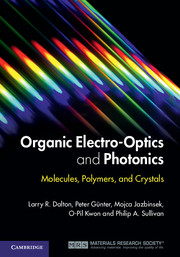Book contents
- Frontmatter
- Dedication
- Contents
- 1 Introduction
- 2 Nonlinear optical effects
- 3 Electro-optic effects
- 4 Molecular nonlinear optics
- 5 Acentric self-assembled films
- 6 Crystalline materials
- 7 Electrically poled organic materials and thermo-optic materials
- 8 Overview of applications
- 9 Organic electro-optic waveguides, switches, and modulators
- 10 Nonlinear optical infrared and terahertz frequency conversion
- 11 Photorefractive effect and materials
- 12 Conclusions and future prospects
- Index
- References
10 - Nonlinear optical infrared and terahertz frequency conversion
Published online by Cambridge University Press: 05 August 2015
- Frontmatter
- Dedication
- Contents
- 1 Introduction
- 2 Nonlinear optical effects
- 3 Electro-optic effects
- 4 Molecular nonlinear optics
- 5 Acentric self-assembled films
- 6 Crystalline materials
- 7 Electrically poled organic materials and thermo-optic materials
- 8 Overview of applications
- 9 Organic electro-optic waveguides, switches, and modulators
- 10 Nonlinear optical infrared and terahertz frequency conversion
- 11 Photorefractive effect and materials
- 12 Conclusions and future prospects
- Index
- References
Summary
Nonlinear optical frequency conversion
As discussed in Chapter 2, there are many different possibilities for converting optical frequencies to other frequencies or even static fields in second-order nonlinear optical materials, such as sum- and difference-frequency generation, including second-harmonic generation and optical rectification (see Fig. 2.2). The big advantage of organic nonlinear optical materials compared with inorganic ones is high nonlinear optical figures-of-merit, reflecting their almost purely electronic response to external fields, as discussed in Section 3.2. Because of this, the best organic materials exhibit considerably higher second-order nonlinear optical susceptibilities compared with the best inorganic materials. This is illustrated in Fig. 10.1, which shows figures-of-merit for second-harmonic generation d2/n3 versus transparency range for various organic and inorganic crystals. One can clearly see that the nonlinear optical figures-of-merit of organic materials can be several orders of magnitude higher than in the best inorganic materials. This makes organic materials extremely attractive for nonlinear optical applications.
In the 1980s, the most attractive frequency conversion applications included frequency doubling because of the above advantages and because of the interest in generating blue or green coherent light by using widely available (near-)infrared laser sources, such as diode lasers [1], Ti:sapphire lasers, and Nd:YAG lasers. The early organic materials considered were transparent in the visible. Later on, organic materials with much higher nonlinear optical susceptibilities were developed, but these are no longer transparent in the visible (see Fig. 10.1) and therefore second-harmonic generation with these materials is of limited applicability. At present, the most attractive frequency-conversion applications with organic materials include infrared and far-infrared light generation, as well as generation of electromagnetic waves in the THz frequency range. In this section we mainly describe infrared frequency conversion possibilities with the best organic crystals, such as DAST, DSTMS, and OH1 (see Chapter 6 for details on these materials), and in the next section we look at THz generation with these and other organic materials.
- Type
- Chapter
- Information
- Organic Electro-Optics and PhotonicsMolecules, Polymers and Crystals, pp. 228 - 249Publisher: Cambridge University PressPrint publication year: 2015
References
- 2
- Cited by



